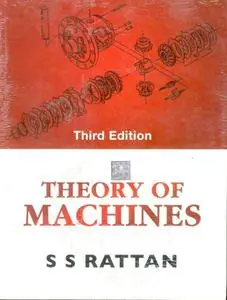S. S. Rattan, "Theory of Machines (3rd edition)"
2009 | ISBN-10: 007014477X | 711 pages | PDF | 27 MB
2009 | ISBN-10: 007014477X | 711 pages | PDF | 27 MB
Theory Of Machines is meant to cover the syllabus for courses over two semesters, namely Kinematics of Machinery and Dynamics of Machinery.
Summary Of The Book
Theory Of Machines is a book for the portions of the two-semester course, covering both Kinematics and Dynamics of Machinery. It is laden with problems and solved examples, providing a comprehensive guide for students looking to understand these two subjects thoroughly.
Theory Of Machines begins with an introduction to different types of motion within machines, such as successfully constrained motion and completely constrained motion. Then, the different components of any machine with respect to kinematics, such as links, joints, cams and kinematic pairs are discussed.
The book then explains velocity and acceleration diagrams in detail, from which the characteristics of motion of the machine can be derived completely. There is also a chapter dedicated to cams, where the reader will learn how to trace the motion of the cam in a geometrical and mathematical manner.
Friction is another pertinent concept that is discussed in length in Theory Of Machines, with a number of situations provided, such as friction in brakes, screw jacks, screw threads and in links. Readers will learn how to use the coefficient of friction for different materials to calculate the heat generated and the amount of wear due to friction.
This book is a standard textbook for all students of the mechanical engineering discipline, presenting all the topics under the syllabus for Kinematics and Dynamics of Machinery in a simple and understandable manner. Some of the important features of Theory Of Machines are a balance between the analytical and graphical approaches, computer programs presented in the C language to make them as user-friendly as possible and close to three hundred and fifty solved examples.
There are also completely new sections covering important topics such as Hartmann and Bobillier construction, Chebychev spacing, and the Euler-Savary equation.
In order to ensure that readers, whether they are students or researchers, get an adequate understanding of the subjects covered, Theory Of Machines also has 510 exercise questions and more than 160 objective type questions, providing a complete examination-level preparation.



